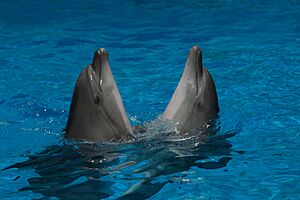Black Sea bottlenose dolphin facts for kids
Quick facts for kids Tursiops truncatus ponticusTemporal range: Holocene
|
|
|---|---|
 |
|
| Conservation status | |
| Scientific classification |
|
| Kingdom: | Animalia |
| Phylum: | Chordata |
| Class: | Mammalia |
| Order: | Artiodactyla |
| Infraorder: | Cetacea |
| Family: | Delphinidae |
| Genus: | Tursiops |
| Species: | |
| Subspecies: |
T. t. ponticus
|
| Trinomial name | |
| Tursiops truncatus ponticus (Barabash-Nikiforov, 1940)
|
|
The Black Sea bottlenose dolphin (Tursiops truncatus ponticus) is a special type of common bottlenose dolphin. Scientists have found small differences in their skulls and genes. These differences make them unique from other bottlenose dolphins. This dolphin lives in the Black Sea. It is not studied as much as the more common Atlantic bottlenose dolphin.
Contents
What Do Black Sea Dolphins Eat and How Do They Live?
Black Sea bottlenose dolphins eat many kinds of fish found near the coast. Their diet includes fish like red mullet, flounder, mullet, anchovy, herring, horse mackerel, and even stingrays.
Sometimes, their usual food, like fish that swim in open water, becomes harder to find. This happens near places where many people live. So, the dolphins start eating fish that live closer to the seafloor. This brings them nearer to the coast where more food is available.
How Do Black Sea Dolphins Live Together?
A study near Crimea looked at how Black Sea bottlenose dolphins live in groups. It showed that these dolphins have special ways of living together. They help each other hunt and find food. They use echolocation (like sonar) to find things underwater. Scientists listened to their sounds to learn about their groups.
The study found that these dolphins live in groups of 2 to 10 individuals. These groups do not separate easily. Instead, they stay together, even if they are not closely related. This shows how important strong social bonds are for Black Sea dolphins.
Special Blood of Black Sea Dolphins
Scientists have also studied the blood of Black Sea bottlenose dolphins. They found that the chemicals in their blood are special. This is because of the unique environment they live in. Even though some studies were done on dolphins in museums, the results still showed that their blood chemistry is unique to their subspecies.
Protecting Black Sea Dolphins
The Black Sea is a popular place for tourists. Many people enjoy boat rides to see dolphins. But these boats often go through areas where dolphins live and feed. More human activity can break up dolphin groups. This can harm their social relationships.
Dangers from Recent Events
The safety of Black Sea dolphins has been greatly affected by recent events. Loud noises and explosions have happened in their feeding areas. Also, pollution from spilled oil and chemicals has increased a lot.
Many dead dolphins have been found on beaches in Turkey, Romania, and Ukraine. Scientists believe that tens of thousands of dolphins died in 2022. Loud underwater sounds from ships and military activities also hurt the dolphins.


